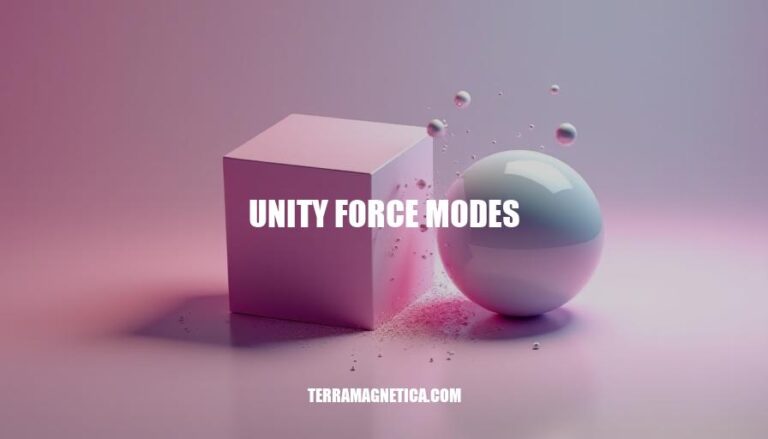


Unity’s Force Modes are essential tools in game development, allowing developers to control how forces are applied to game objects with Rigidbody components. There are four primary Force Modes:
These modes are crucial for creating realistic and dynamic interactions in games, influencing how objects move, collide, and respond to forces.
Here are the different Unity force modes and how they affect a GameObject:
Force: Applies a continuous force to the GameObject, considering its mass. This mode is useful for simulating real-world forces like gravity or wind. The effect depends on the mass and the simulation step length (deltaTime) .
Acceleration: Applies a continuous acceleration to the GameObject, ignoring its mass. This mode is useful when you want to apply a force that doesn’t depend on the object’s mass, like a rocket thruster. The effect depends on the simulation step length but not on the mass .
Impulse: Applies an instant force to the GameObject, considering its mass. This mode is useful for simulating sudden impacts or explosions. The effect depends on the mass but not on the simulation step length .
VelocityChange: Instantly changes the velocity of the GameObject, ignoring its mass. This mode is useful for instant changes in speed or direction, like a teleportation effect. The effect doesn’t depend on the mass or the simulation step length .
Each mode provides a different way to manipulate the physics of a GameObject, allowing for a wide range of dynamic behaviors in your game.
Here are the methods for applying Unity force modes using Rigidbody.AddForce and ArticulationBody.AddForce, along with code snippets for each force mode.
ForceMode.Force
Rigidbody rb = GetComponent<Rigidbody>();
rb.AddForce(Vector3.forward * 10f, ForceMode.Force);
ForceMode.Acceleration
Rigidbody rb = GetComponent<Rigidbody>();
rb.AddForce(Vector3.up * 5f, ForceMode.Acceleration);
ForceMode.Impulse
Rigidbody rb = GetComponent<Rigidbody>();
rb.AddForce(Vector3.right * 20f, ForceMode.Impulse);
ForceMode.VelocityChange
Rigidbody rb = GetComponent<Rigidbody>();
rb.AddForce(Vector3.left * 15f, ForceMode.VelocityChange);
ForceMode.Force
ArticulationBody ab = GetComponent<ArticulationBody>();
ab.AddForce(Vector3.forward * 10f, ForceMode.Force);
ForceMode.Acceleration
ArticulationBody ab = GetComponent<ArticulationBody>();
ab.AddForce(Vector3.up * 5f, ForceMode.Acceleration);
ForceMode.Impulse
ArticulationBody ab = GetComponent<ArticulationBody>();
ab.AddForce(Vector3.right * 20f, ForceMode.Impulse);
ForceMode.VelocityChange
ArticulationBody ab = GetComponent<ArticulationBody>();
ab.AddForce(Vector3.left * 15f, ForceMode.VelocityChange);
These snippets illustrate how to apply different force modes using both Rigidbody and ArticulationBody in Unity.
Here are practical use cases for each Unity ForceMode in game development:
Use Case: Applying continuous force over time.
Scenario: Simulating wind pushing a sailboat. The force is applied continuously, taking the object’s mass into account, resulting in a gradual acceleration.
Use Case: Applying force without considering the object’s mass.
Scenario: Moving a spaceship in space. Since mass is irrelevant in a vacuum, this mode ensures consistent acceleration regardless of the spaceship’s mass.
Use Case: Applying an instant force.
Scenario: Simulating a cannon firing a cannonball. The force is applied instantly, giving the cannonball an immediate velocity boost.
Use Case: Instant velocity change without considering mass.
Scenario: Implementing a teleportation effect where an object instantly changes its velocity to match a new direction or speed, ignoring its mass.
Each mode offers unique advantages depending on the physical behavior you want to simulate in your game.
Here are some best practices for using Unity Force Modes to achieve desired physics behaviors in games:
FixedUpdate to ensure consistent physics calculations.Interpolate and Collision Detection settings on Rigidbody to balance performance and accuracy.ForceMode.Force and ForceMode.Impulse.Update instead of FixedUpdate can cause inconsistent physics behavior.By following these practices, you can achieve more realistic and optimized physics behaviors in your Unity games. Happy coding!
Force modes are essential for simulating realistic and dynamic game physics in Unity. Each mode serves a specific purpose:
When using Force Modes, keep the following best practices in mind:
FixedUpdate to ensure consistent physics calculations.Interpolate and Collision Detection, to balance performance and accuracy.Common pitfalls to avoid include:
ForceMode.Force and ForceMode.Impulse.Update instead of FixedUpdate, causing inconsistent physics behavior.By mastering Unity’s Force Modes and following these guidelines, you’ll be able to create more realistic and engaging game physics.